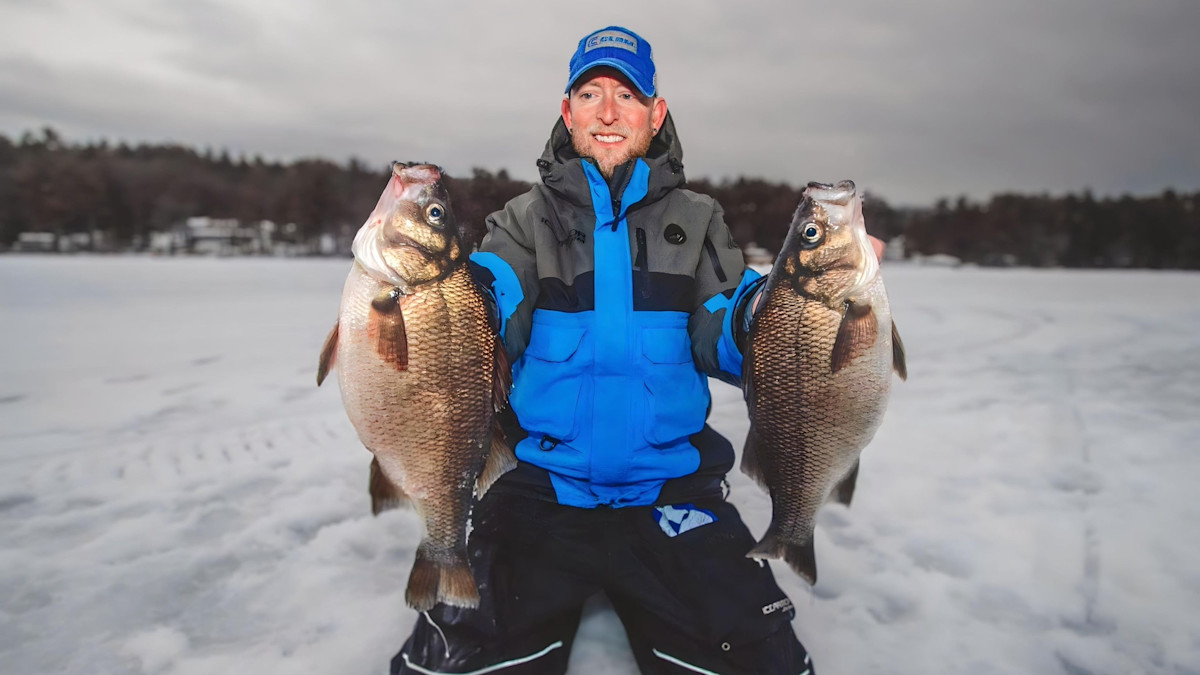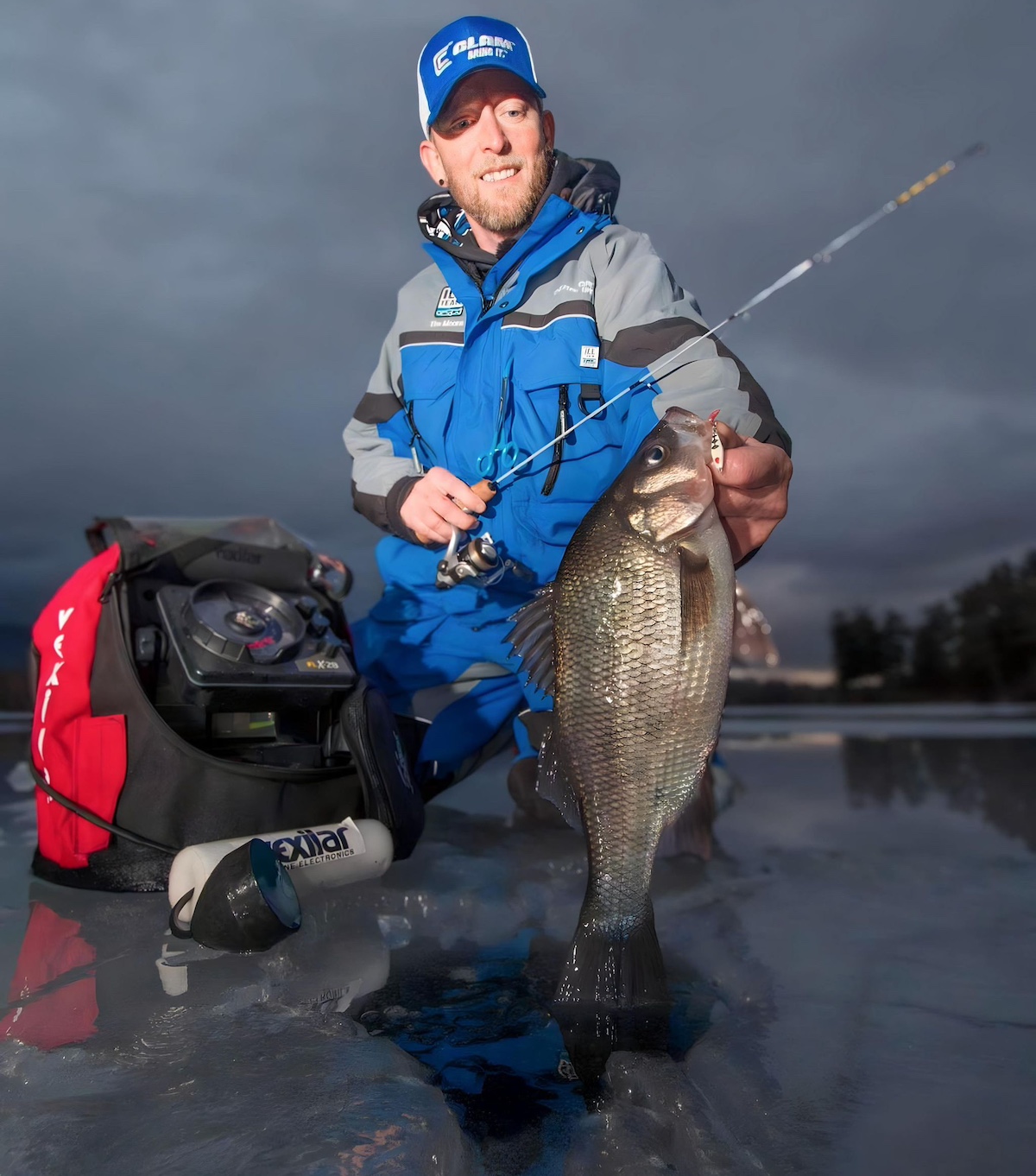
Every outdoors person has their own Everest. A game or fish species that stands out as the ultimate challenge or the greatest prize in whatever sporting discipline they favor. For big game hunters, it might be climbing into the high country for Dall Sheep or hearing the distant bugle of a bull elk. For fly anglers, it can be wading pristine rivers for wily steelhead or wandering ocean flats in search of permit. However, if you’re a panfish angler, there’s no doubt that the very top of the proverbial mountain is the white perch.
These small but hardy fish are some of the most difficult to find, hardest fighting, and best-tasting fish in freshwater. For ice fishing anglers, they stand out as the ultimate prize. Catching white perch through the ice can be a true challenge—many anglers spend hours and even entire days without a strike. Yet, with the right strategies and equipment, you can catch a limit of these prized panfish every time you hit the hardwater.
How to Find White Perch Beneath the Ice
White perch aren’t really a perch at all. They are actually members of the temperate bass which includes striped bass and white bass. A brackish-water fish, white perch first migrated from the Atlantic Coast to the Great Lakes during the construction of the Erie Canal. In many parts of the United States, they are considered to be an invasive species that devours baitfish that other gamefish like walleye, lake trout, and smallmouth bass rely on for forage. However, unlike many other invasive species, which are generally treated with disdain, the encroachment of white perch has almost been celebrated by anglers as their aggressive winter feeding habits have made them prime and prized ice fishing quarry.
Like their more well-known cousins, the striped bass, white perch travel in large schools and live a generally nomadic lifestyle, roaming from one area to the next in search of their next meal. They generally stay in deeper, more open areas of water, pursuing schools of baitfish. This can make them incredibly challenging to find—unless, of course, you know where to look.
“White perch like to hang out in basins. That’s kind of where they go,” white perch guru Tim Moore, owner and operator of Tim Moore Outdoors guide service on New Hampshire’s Lake Winnipesaukee, said. “Generally, I like to target them in 30 feet of water, though I’ve found them in as deep as 50 feet and as shallow as 15 feet, in open basins (depressions in the lake bottom), and along inside turns. These are sort of underwater coves in 27 to 30 feet of water where the contours of the lake bottom cut in and then shoot back out again towards deeper water.”
To find these open basins in lakes with white perch, anglers often have to rely on both bathymetric maps and electronics to find basins and inside turns. These underwater structures are vital for finding and staying on top of the fish. Often, because of the fish’s wandering nature, anglers must travel a bit and map out several different locations with white perch potential.
“When I’m trying to find a school of fish, I put my Hummingbird Helix fish finder on my snowmobile and I’ll take a look at my lake map,” Moore told MeatEater. “I’ll find four or five spots that look good or that produced for me in the past, and then I’ll set up by drilling some holes. White perch act a lot like stripers where they hunt in big schools of the same age class. They’ll work together to push bait into inclines along the bottom, corral them, and then move in together to feed. So, in the morning, I’ll do a lot of sitting in one spot and waiting for a school to move in, but if it’s not producing or it’s getting late in the day, I’ll do some running and gunning and use my electronics to find the fish.”
Moore will either look for schools of white perch themselves or he’ll look for the schools of baitfish that the perch are hunting. Once he finds a few fish or a likely-looking pod of baitfish on his fish finder, he’ll start jigging or set tip-ups in the area and wait for a strike.
“It can be a lot like waking a sleeping giant once you find the fish,” Moore said. “We’ll hook one or two in a row and then all of a sudden, we’ll realize there’s like 50 perch down there, and the action becomes completely non-stop! There are points where the fishing is so good when the perch are in a complete feeding frenzy, you could probably drop a penny down the hole and it would get eaten on the way down.”

Gearing up for White Perch
While considered to be panfish by most of the ice fishing fraternity, white perch are such hard fighters that usually require slightly heavier equipment than most anglers would use for bluegill, crappie, and yellow perch. Light- to medium-action jigging rods are much better for the hard-fighting fish than the ultralight rods used for other panfish. String both jigging rods and tip-ups with heavier six- to eight-pound test fishing line and leaders which will help you land your perch quickly so you can get your bait back down the hole to catch another before the school moves on.
White perch can be finicky and their feeding windows short, so most anglers prefer to bring a couple jigging rods out onto the ice with them, keeping them rigged and ready with different lures. This allows you to quickly switch between lures and baits and get back on top of feeding fish quickly should your original set-up not be producing. Likewise, if you use tip-ups, carry a container of heavy #5 and #6 split shot so that you can get baits back down quickly when you’re on a hot bite.
Since moving and covering water is such a theme with white perch, a good sled is often essential for moving gear from one spot to the next. Additionally, electronics like fish finders, transducers, and underwater cameras are often vital for success. Finding the roving schools of perch is more than half the battle. A good electric or gas-powered ice auger is also incredibly helpful as it allows you to drill holes quickly so you can prospect and move on without having to spend a ton of time breaking through the ice with a chisel or hand auger.
Best Ice Fishing Baits and Lures for White Perch
Baits and lures for white perch can vary and often depend on the different types of forage available in the water that you’re fishing. White perch will occasionally key on things like plankton and insect nymphs, but for the most part, they’re predators that hunt schooling baitfish like smelt, golden shiners, and different species of minnows. Accordingly, the most effective baits and lures are baitfish imitations and live bait native to the body of water you’re fishing.
Jigging spoons are easily the most effective lures for white perch as they imitate a variety of baitfish. However, your typical jigging spoons aren’t designed for deep-water fishing and are often too light to get down to the perch, so heavier spoons like the Kastmaster, the Clam Flutter Spoon, and the War Eagle are often your best bets. For a bit of extra effectiveness, try tipping these spoons with a bit of protein, such as a live minnow, a chunk of nightcrawler, or a maggot. It can be just the thing to convince a reluctant white perch to strike.
Panfish jigs can also be quite effective for white perch but they often encounter the same problem of being too light for catching perch in deep water.
“The Clam Epoxy Drop is probably the most effective lure for jigging through the ice,” Tim Moore told MeatEater. “But the problem is it’s a 1/64th ounce jig, and it sometimes takes too long to sink. When you want to get on top of a moving school, you want a lure that will get down to them quickly, so the spoons are often much more effective. However, we do catch a lot of fish on small tungsten panfish jigs, tipped with spikes or soft plastics, or pieces of worm, because a little tiny bit of meat always helps.”
Tip-up anglers can have some extraordinary fishing using live bait, so long as the bait they are using matches the white perch’s natural forage. Often, this means you’ve got to spend a few days catching your own bait before the ice freezes and keeping them alive or that you’re only buying bait that’s native to the waterbody you’re fishing.
“There are days when live bait really shines,” says Moore. “On Lake Winnipesaukee, where I typically fish, we have an incredible population of rainbow smelt, which are the main forage fish for the white perch. A live smelt on a tip-up set up along an inside turn will almost always catch a fish, especially on days when the perch are keyed in on them.”
Set up tip-ups for white perch by tying a two- to four-foot length of six- to eight-pound monofilament line to the tip-up line using a barrel swivel. Attach two to three #5 to #6 split shot and then a size eight to size six bait hook. Hook a bait fish through the center of its back, keeping the point of the hook above the backbone and vital organs so that it stays alive and wriggling. Then, lower the bait into the hole and let it drop to the bottom before retrieving a foot or two of the line so that the bait is hanging suspended just above bottom and can swim freely right into a hungry perch’s mouth.

Sitting on a Perch
Most anglers play the panfish game for the numbers rather than the thrill. It’s about the simple pleasure of easily finding and pulling a bunch of small, wriggling fish out onto the ice and then bringing them home for a hearty meal. Yet that’s why white perch are considered the ultimate panfish—they provide all of that and more.
“White perch are pound for pound one of the hardest fighting fish in the water,” Moore said. “They’re wide and thick, and they’re diggers that dive straight for the bottom. When you hook a two-pounder, you’ve got to hang on like it was a massive lake trout. They’re also one of the best-eating fish in the water. White perch don’t taste like a typical freshwater fish, there’s something almost oceanic about them. If you’re a big seafood eater, you’ll absolutely love white perch.”
You can spend hours wandering the ice in search of them, and when you do find a big school of white perch, you can absolutely wear yourself out trying to battle them to the surface. Yet they are still a fish of simplicity that willingly and voraciously strike, allowing you to pile them up on the ice and fill your freezer with filets. That is why white perch will always remain at the top tier, roaming beneath the ice and lying in wait for ice anglers searching for a bit of panfish glory.
Images via Tim Moore.



Conversation